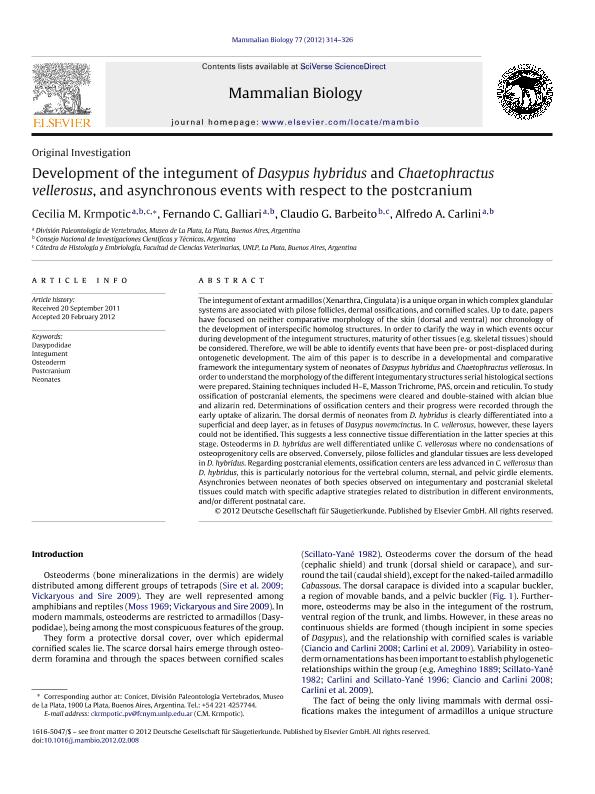Mostrar el registro sencillo del ítem
dc.contributor.author
Krmpotic, Cecilia Mariana

dc.contributor.author
Galliari, Fernando Carlos

dc.contributor.author
Barbeito, Claudio Gustavo

dc.contributor.author
Carlini, Alfredo Armando

dc.date.available
2019-05-08T21:49:06Z
dc.date.issued
2012-09
dc.identifier.citation
Krmpotic, Cecilia Mariana; Galliari, Fernando Carlos; Barbeito, Claudio Gustavo; Carlini, Alfredo Armando; Development of the integument of Dasypus hybridus and Chaetophractus vellerosus, and asynchronous events with respect to the postcranium; Elsevier Gmbh; Mammalian Biology; 77; 5; 9-2012; 314-326
dc.identifier.issn
1616-5047
dc.identifier.uri
http://hdl.handle.net/11336/75926
dc.description.abstract
The integument of extant armadillos (Xenarthra, Cingulata) is a unique organ in which complex glandular systems are associated with pilose follicles, dermal ossifications, and cornified scales. Up to date, papers have focused on neither comparative morphology of the skin (dorsal and ventral) nor chronology of the development of interspecific homolog structures. In order to clarify the way in which events occur during development of the integument structures, maturity of other tissues (e.g. skeletal tissues) should be considered. Therefore, we will be able to identify events that have been pre- or post-displaced during ontogenetic development. The aim of this paper is to describe in a developmental and comparative framework the integumentary system of neonates of Dasypus hybridus and Chaetophractus vellerosus. In order to understand the morphology of the different integumentary structures serial histological sections were prepared. Staining techniques included H-E, Masson Trichrome, PAS, orcein and reticulin. To study ossification of postcranial elements, the specimens were cleared and double-stained with alcian blue and alizarin red. Determinations of ossification centers and their progress were recorded through the early uptake of alizarin. The dorsal dermis of neonates from D. hybridus is clearly differentiated into a superficial and deep layer, as in fetuses of Dasypus novemcinctus. In C. vellerosus, however, these layers could not be identified. This suggests a less connective tissue differentiation in the latter species at this stage. Osteoderms in D. hybridus are well differentiated unlike C. vellerosus where no condensations of osteoprogenitory cells are observed. Conversely, pilose follicles and glandular tissues are less developed in D. hybridus. Regarding postcranial elements, ossification centers are less advanced in C. vellerosus than D. hybridus, this is particularly notorious for the vertebral column, sternal, and pelvic girdle elements. Asynchronies between neonates of both species observed on integumentary and postcranial skeletal tissues could match with specific adaptive strategies related to distribution in different environments, and/or different postnatal care.
dc.format
application/pdf
dc.language.iso
eng
dc.publisher
Elsevier Gmbh

dc.rights
info:eu-repo/semantics/openAccess
dc.rights.uri
https://creativecommons.org/licenses/by-nc-sa/2.5/ar/
dc.subject
Dasypodidae
dc.subject
Integument
dc.subject
Neonates
dc.subject
Osteoderm
dc.subject
Postcranium
dc.subject.classification
Otras Ciencias Biológicas

dc.subject.classification
Ciencias Biológicas

dc.subject.classification
CIENCIAS NATURALES Y EXACTAS

dc.title
Development of the integument of Dasypus hybridus and Chaetophractus vellerosus, and asynchronous events with respect to the postcranium
dc.type
info:eu-repo/semantics/article
dc.type
info:ar-repo/semantics/artículo
dc.type
info:eu-repo/semantics/publishedVersion
dc.date.updated
2019-05-06T14:39:45Z
dc.journal.volume
77
dc.journal.number
5
dc.journal.pagination
314-326
dc.journal.pais
Alemania

dc.journal.ciudad
Berlín
dc.description.fil
Fil: Krmpotic, Cecilia Mariana. Consejo Nacional de Investigaciones Científicas y Técnicas. Centro Científico Tecnológico Conicet - La Plata; Argentina. Universidad Nacional de La Plata. Facultad de Ciencias Naturales y Museo. Departamento Científico de Paleontología de Vertebrados; Argentina. Universidad Nacional de La Plata. Facultad de Ciencias Veterinarias. Departamento de Ciencias Básicas. Cátedra de Histología y Embriología; Argentina
dc.description.fil
Fil: Galliari, Fernando Carlos. Consejo Nacional de Investigaciones Científicas y Técnicas. Centro Científico Tecnológico Conicet - La Plata; Argentina. Universidad Nacional de La Plata. Facultad de Ciencias Naturales y Museo. Departamento Científico de Paleontología de Vertebrados; Argentina
dc.description.fil
Fil: Barbeito, Claudio Gustavo. Consejo Nacional de Investigaciones Científicas y Técnicas. Centro Científico Tecnológico Conicet - La Plata; Argentina. Universidad Nacional de La Plata. Facultad de Ciencias Veterinarias. Departamento de Ciencias Básicas. Cátedra de Histología y Embriología; Argentina
dc.description.fil
Fil: Carlini, Alfredo Armando. Consejo Nacional de Investigaciones Científicas y Técnicas. Centro Científico Tecnológico Conicet - La Plata; Argentina. Universidad Nacional de La Plata. Facultad de Ciencias Naturales y Museo. Departamento Científico de Paleontología de Vertebrados; Argentina
dc.journal.title
Mammalian Biology

dc.relation.alternativeid
info:eu-repo/semantics/altIdentifier/doi/http://dx.doi.org/10.1016/j.mambio.2012.02.008
dc.relation.alternativeid
info:eu-repo/semantics/altIdentifier/url/https://www.sciencedirect.com/science/article/pii/S1616504712000328
Archivos asociados
